Sheila Keegan
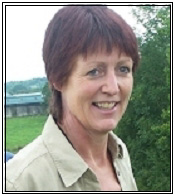 The
July 4, 1999 issue of London’s The Sunday Telegraph newspaper
carried an excellent full page account of Sheila’s experience
when as a 16 year old student touring Ireland she got caught-up
in rioting in the Bogside during which she took a photograph of
children making petrol bombs which were being used in the
fracas. The article described that event and a trip back 30
years later during which she located and interviewed the
children in the photograph. Sheila is the daughter of Betty
Tinneny of Killahurk, Carrigallen.
The
July 4, 1999 issue of London’s The Sunday Telegraph newspaper
carried an excellent full page account of Sheila’s experience
when as a 16 year old student touring Ireland she got caught-up
in rioting in the Bogside during which she took a photograph of
children making petrol bombs which were being used in the
fracas. The article described that event and a trip back 30
years later during which she located and interviewed the
children in the photograph. Sheila is the daughter of Betty
Tinneny of Killahurk, Carrigallen.
***
It was August 12, 1969 and I stood in Rossville Street, in the
Bogside district of Londonderry, surrounded by a Catholic
crowd. Earlier in the day, the Apprentice Boys had marched
through the city, in their annual comoration of the Siege of
1688. Tension between Catholics and Protestants was palpable.
Trouble was expected.
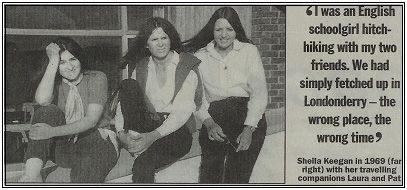 It
started with jeers and stone throwing.Within hours, it had
escalated into fierce rioting between Catholics and the RUC.
The Battle of the Bogside had begun, marking the beginning of 30
years of violence.
It
started with jeers and stone throwing.Within hours, it had
escalated into fierce rioting between Catholics and the RUC.
The Battle of the Bogside had begun, marking the beginning of 30
years of violence.
I
stood, transfixed as a line of RUC officers 20 abreast, wielding
batons and riot shields, broke through makeshift barricades and
charged straight into us. A crowd of Loyalists taking advantage
of the breach, followed behind the catholic crowd scattered in
panic.
I
was not a rioter, I was an English schoolgirl hitchhiking around
Ireland in the summer holidays with my friends, Pat and Laura.
We each had Irish Catholic parents. They believed Ireland would
be a safe place for our first solo holidays. We had simply
fetched up in Londonderry – the wrong place, the wrong time.
Disbelief at facing a wall of charging policemen gave way to
panic. We turned and ran. We scaled a high wall and sought
sanctuary in nearby flats.
It was impossible to leave the Bogside that night. A Catholic
family, the Quiggs, kindly put us up and we left the next
morning.
I
knew little of Irish history at that time. My father talked of
being a runner for the IRA as a child. He told stories of the
Black and Tans cruising the countryside in drunken mobs,
randomly shooting at passers-by and burning down cottages –
along with their inhabitants. He described how in Belfast, pigs
heads were stuck on spikes with the label “Cured in Rome”.
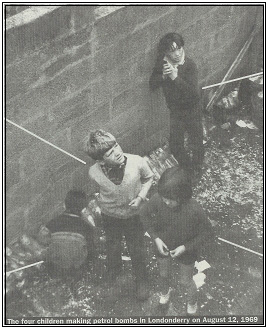
I had laughed and
walked away. What had that to do with my life as a teenager in
London in the late 1960? I was listening to Pink Floyd in Hyde
Park. I was more interested in Vietnam than Ulster.
Suddenly and inadvertently, I had entered my fathers’ world.
I
took six photos that day with my Kodak Instamatic: the
Apprentice Boys’ march, the Rossville Street crowd, four
children making petrol bombs.
I
did not visit Londonderry again for 30 years, not until I
returned last week to make a programme for Radio 4. I wanted to
find the people in the pictures, to see what had happened to
them in the intervening years, to find out how their lives had
parralled the Troubles. In particular I wanted to find the
children in the petrol bomb picture. Had they grown up to become
bank managers? IRA men? Would they want to be found?
With the help of the local newspaper, the Derry Journal, I
tracked down the family we had stayed with. Then I hit luck.
Sure, that’s one of the Kelly brothers, probably Tony,” said a
lady at the community centre after studying my photograph.
I
was sent to a taxi rank in a dark street to find Patty Kelly,
Tony’s brother. From there, I was directed to Paddy’s house. I
arrived unannounced asking for Tony. Paddy was wary, but
invited me in. I showed him the photograph.
“No, that’s not Tony,” he said. I felt deflated. Had I been
sent on a false trail? Later I discovered that Tony was an IRA
prisoner who had escaped from Long Kesh. He is still on the
run.
Paddy seized me up for an hour, while we talked about the peace
talks and my Dad. Then he picked up the photograph again.
“That one there. I think that’s Jim Muldoon.”
He phoned Jim, he agreed to come round to Paddy’s after work.
Jim is a burly, humorous man, now working as a butcher. He was
delighted to see the photo of his earlier exploits.
“I was 10 or 11 then,” he said. “Those petrol bombs were
shipped down to William Street. Someone older would have put in
the petrol and the rags. We were on school break. It was to
pass the time. You were never doing it hurt anybody. If my Mom
had seen me she would have killed me. She thought I was a
saint.
“If I hadn’t been involved, I would have been the odd one out.
I use to get out of bed at night, put my mask on; you had to
follow the crowd. I thought I was the Lone Ranger; it was all a
game, but there were bullets sometimes.
“You did well to track me down. My wife can’t even find me some
weeks.”
Jim pointed to the dark haired boy leaning against the wall.
“Hey, Paddy. Isn’t that your brother Mickey?” 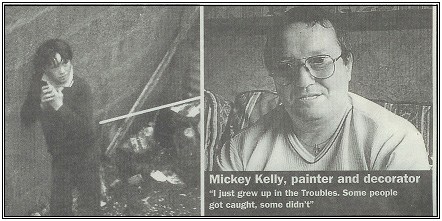
It was. I was
taken to Mickey’s flat. Mickey, too was pleased to see me. He
was married and worked as a painter and decorator.
“There were some crazy times then,” he said, “We were only
wains. The police were trying to move in and the wains were
making petrol bombs and the big fellas would come up.
“There use to be a side gate and we’d take the petrol bombs and
put them in the boot of their car, and then we would go up and
down the barricades. It wasn’t too bad as long as you weren’t
smoking. It made us feel big then, helping. My Mom could smell
the petrol on my cloths, but she couldn’t do much.
“I just grew up in the Troubles same as everybody else. Some
people got caught. Some people didn’t get caught. At the very
top of the Rossville flats, the army had a post. There was a
fire door and a young fellow set a booby trap and the army came
and the booby trap went off.
“Bloody Sunday was the scariest time of the lot. I was in
William Street with two boys behind me and they shot the two
boys whom I was standing beside. They just dropped beside me.
One of the boys was killed. I was 14.
“It’s not as bad now as it was. My wife works in a factory.
Two of her friends are Protestant and we went to Blackpool last
year with them.”
Mickey pointed to the other two children in the picture. “They
are Gallagher children. That’s Lizzie and Denis Gallagher.
Denis got life in jail. He’s out now,”
My next visit was to Mrs. Gallagher, the children’s mother. She
reared 12 children in a staunchly republican family and was
proud of her son Denis.
“I don’t regret one minute of what he was in. I don’t. He was
fighting for his country. That’s all that mattered to me.
There was not trouble with Denis at all. He was very good.”
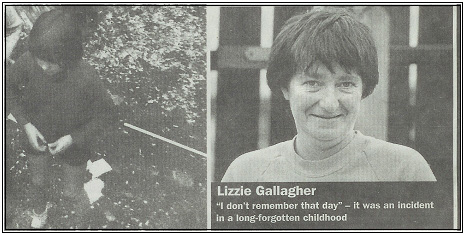 “Mrs.Gallagher’s
daughter, Lizzie, was visiting her mother but she was quiet. ‘I
don’t remember,” she replied, when I asked her about August 12,
1969. For her it was another day in a long-forgotten childhood.
“Mrs.Gallagher’s
daughter, Lizzie, was visiting her mother but she was quiet. ‘I
don’t remember,” she replied, when I asked her about August 12,
1969. For her it was another day in a long-forgotten childhood.
The next day, however, I met Denis. He was a cautious man,
slightly wary of me, but welcoming and hospitable. He lives
with his wife and two small children. Like Mickey, he now works
as a painter and decorator.
He looked at the photograph wistfully. “At that times all the
wains were running around and helping as much as possible. I
remember the air being full of CS gas; we were always choking.
Later it became really serious. I ended up in Long Kesh for 14
years, all because of the Troubles.
“I had just turned 19. I was arrested and charged with
handling explosives and attempted murder. I got two life
sentences for it. I suppose today, looking back at that
photograph, that was my starting off on the way to prison.
“I never had regrets. I never ever believed that I was wrong.
It was just the way things worked out. Violence was part of
life. I always believed there will never be a solution until
there is total democracy in this country. I would like to see a
united Ireland: you can’t divide a country then tell people they
can have no say in it.
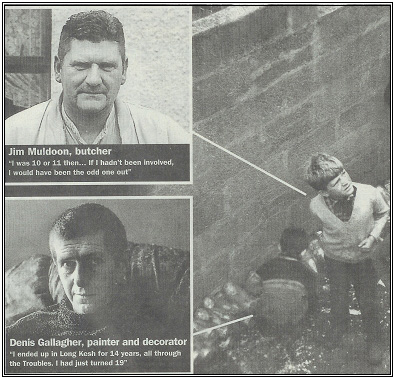 “Fourteen
years is a big chunk of anyone’s life, but hundreds went through
the same thing, on both sides. I would rather have had a normal
life, a life like anybody else: to have got a job, got married
before I did. I am nearly 40 years of age and my eldest child
is only six. I should have been going to my daughter’s wedding
now.
“Fourteen
years is a big chunk of anyone’s life, but hundreds went through
the same thing, on both sides. I would rather have had a normal
life, a life like anybody else: to have got a job, got married
before I did. I am nearly 40 years of age and my eldest child
is only six. I should have been going to my daughter’s wedding
now.
“But I’m glad the violence has stopped. If it’s not going to be
resolved in the near future, there is no point in people dying.
It is up to the people to implement the agreement or it will
spiral out of control again.”
When I left Londonderry in 1969, I was in a state of
considerable excitement after all that had happened. I was just
as excited when I left last week; my trip could not have been
more successful. Yet it was excitement tinged with deep
sadness; a sadness for all that has happened in Northern Ireland
in the 30 years since that first visit, and sadness that I had
not made time to listen to my father. It is too late now. He
died in 1986.
Article and photos courtesy of Sheila Keegan.